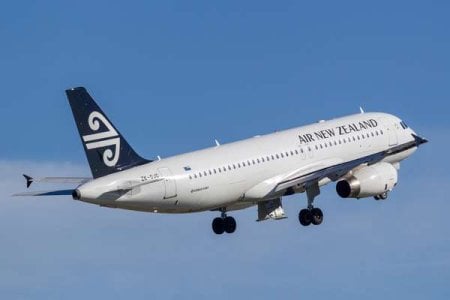Flight fright: Airline passengers face emergency landing after crew assault incident
- Replies 2
Travelling by air has become a routine part of modern life, with many of us hopping on planes for holidays, family visits, or business trips.
We expect these journeys to be smooth and uneventful, but occasionally, the unexpected happens, turning a routine flight into a headline-making incident.
This was the case for passengers aboard an Air New Zealand flight bound for Perth, which was abruptly diverted due to a serious disturbance.
Flight NZ176, en route from Perth to Auckland, had to make an emergency landing in Melbourne at 1:40 AM on Wednesday, October 23, approximately three hours after takeoff.
The flight, which began as any other, took a dramatic turn when a 23-year-old New Zealand man allegedly assaulted a crew member.
The altercation was serious enough to affect the performance of the crew, prompting the pilot to make an emergency landing.
This decision underscores the importance of safety in the skies, where the actions of a single individual can have significant consequences for everyone on board.

Upon landing, Australian Federal Police officers were quick to respond, boarding the plane and removing the man from the flight.
The swift action of the authorities is a testament to the rigorous security protocols in place to handle such situations.
The man was subsequently charged with one count of assaulting crew affecting the performance of their duty and was scheduled to appear in the Broadmeadows Magistrates Court.
For the passengers, the ordeal was far from over. They waited on the tarmac for 90 minutes, a delay that no doubt caused frustration and anxiety.
However, the crew's professional handling of the incident likely provided some reassurance during this time.
Once the situation was under control, passengers reboarded and continued their journey to Auckland.
Air New Zealand spokesman David Morgan expressed that while the crew was well-prepared for such incidents, it was undoubtedly confronting for passengers.
‘Incidents like this are distressing for our customers and our people, and we have zero tolerance for this sort of behaviour on our aircraft,’ he stated.
Interestingly, this was not the only recent incident involving Air New Zealand flights.
Just four days prior, a bomb scare on flight NZ-247 as it approached Sydney from Wellington at about 4:50 PM on Saturday, October 19, caused alarm.
The flight was granted permission to land and did so safely at 5:37 PM, where an extensive emergency response team, including tactical operations unit, paramedics and firefighters, met it.
The A320 airliner, carrying 154 staff and passengers, was isolated on a separate runway for about an hour before passengers could disembark.
In both cases, the Australian Federal Police played a crucial role in managing the situations ensuring the safety of passengers and crew.
While the bomb scare was ultimately deemed to pose no danger to the public, the AFP said that ‘investigations are continuing’, reflecting the seriousness with which such threats are taken.
As air travel continues to face its share of unexpected challenges, incidents like the emergency landing of Flight NZ176 serve as a reminder of the unpredictability in the skies.
Just as passengers dealt with this situation, another recent flight encountered its own turmoil due to disruptive behaviour on board.
Such events highlight the ongoing issues faced by airlines and the impact they can have on the flying experience.

Have you ever experienced an emergency landing or a significant in-flight incident? How did the airline handle the situation, and what was your reaction? Share your stories with us in the comments below. Your experiences can help inform and prepare fellow travellers for the unexpected twists that can occur when flying.
We expect these journeys to be smooth and uneventful, but occasionally, the unexpected happens, turning a routine flight into a headline-making incident.
This was the case for passengers aboard an Air New Zealand flight bound for Perth, which was abruptly diverted due to a serious disturbance.
Flight NZ176, en route from Perth to Auckland, had to make an emergency landing in Melbourne at 1:40 AM on Wednesday, October 23, approximately three hours after takeoff.
The flight, which began as any other, took a dramatic turn when a 23-year-old New Zealand man allegedly assaulted a crew member.
The altercation was serious enough to affect the performance of the crew, prompting the pilot to make an emergency landing.
This decision underscores the importance of safety in the skies, where the actions of a single individual can have significant consequences for everyone on board.

An Air New Zealand passenger was arrested for assaulting a crew member, prompting the flight's diversion. Credit: Shutterstock
Upon landing, Australian Federal Police officers were quick to respond, boarding the plane and removing the man from the flight.
The swift action of the authorities is a testament to the rigorous security protocols in place to handle such situations.
The man was subsequently charged with one count of assaulting crew affecting the performance of their duty and was scheduled to appear in the Broadmeadows Magistrates Court.
For the passengers, the ordeal was far from over. They waited on the tarmac for 90 minutes, a delay that no doubt caused frustration and anxiety.
However, the crew's professional handling of the incident likely provided some reassurance during this time.
Once the situation was under control, passengers reboarded and continued their journey to Auckland.
Air New Zealand spokesman David Morgan expressed that while the crew was well-prepared for such incidents, it was undoubtedly confronting for passengers.
‘Incidents like this are distressing for our customers and our people, and we have zero tolerance for this sort of behaviour on our aircraft,’ he stated.
Interestingly, this was not the only recent incident involving Air New Zealand flights.
Just four days prior, a bomb scare on flight NZ-247 as it approached Sydney from Wellington at about 4:50 PM on Saturday, October 19, caused alarm.
The flight was granted permission to land and did so safely at 5:37 PM, where an extensive emergency response team, including tactical operations unit, paramedics and firefighters, met it.
The A320 airliner, carrying 154 staff and passengers, was isolated on a separate runway for about an hour before passengers could disembark.
In both cases, the Australian Federal Police played a crucial role in managing the situations ensuring the safety of passengers and crew.
While the bomb scare was ultimately deemed to pose no danger to the public, the AFP said that ‘investigations are continuing’, reflecting the seriousness with which such threats are taken.
As air travel continues to face its share of unexpected challenges, incidents like the emergency landing of Flight NZ176 serve as a reminder of the unpredictability in the skies.
Just as passengers dealt with this situation, another recent flight encountered its own turmoil due to disruptive behaviour on board.
Such events highlight the ongoing issues faced by airlines and the impact they can have on the flying experience.
Key Takeaways
- An Air New Zealand passenger was arrested for assaulting a crew member, leading to the diversion of the flight.
- The incident occurred on a flight to Perth, and the man was charged and due to appear in court.
- Passengers faced a 90-minute delay on the tarmac before they could continue their journey to Auckland.
- The airline emphasised a zero-tolerance policy for such behaviour and cited the well-being of customers and staff as a priority.







